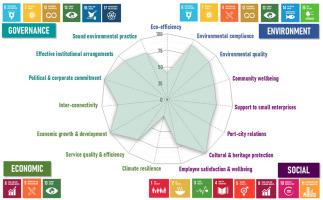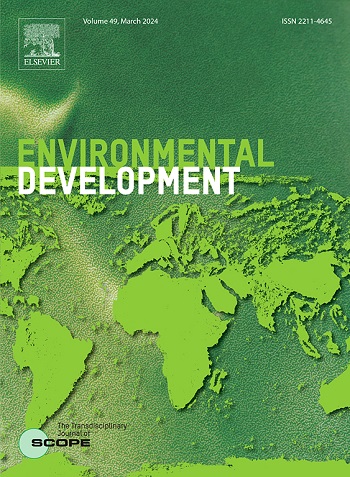Circles of port sustainability: A novel method combining global comparability and local relatability in performance assessment
IF 4.7
2区 环境科学与生态学
Q2 ENVIRONMENTAL SCIENCES
引用次数: 0
Abstract
Ports are increasingly ‘greening’ operations to protect their ‘license to operate’ by integrating social-environmental considerations into their management and reporting on their sustainability performance. In this research, we develop a novel method for port sustainability performance (PSP) assessment that combines science-based knowledge with place-based contextualisation. Specifically, we address a recognised challenge of combining global (‘top-down’) techno-scientifically oriented indicators with place-based locally relatable (‘bottom-up’) contexts in sustainability performance, in addition to addressing limitations encountered in empirical verification. First, a critical evaluation of the international literature on port sustainability assessments is undertaken to distil commonalities in global performance indicators, and to identify typical frames used in the design of sustainability performance indices. We apply this learning, together with place-based experiential knowledge, to develop a science-based framework for a Port Sustainability Performance (PSP) Index that is explicitly aligned with the Sustainability Development Goals (SDGs). We then apply a co-design process to demonstrate local customisation of the index to derive place-based quantifiable measures and targets. Further, for easy-to-use empirical verification, a simple spreadsheet is applied to develop a flexible weighted scoring matrix. The matrix uses place-based rating systems for selected measures and associated targets, and aggregates allocated scores into informative outputs. Finally, the concept of Circles of Sustainability is adapted for ports to visually display sustainability performance, in alignment with related SDGs. This research contributes to bridging the science-practice divide in reporting on port sustainability performance.

港口可持续性圈:绩效评估中全球可比性与地方相关性相结合的新方法
港口正日益 "绿化 "其运营,通过将社会环境因素纳入其管理并报告其可持续发展绩效来保护其 "运营许可"。在这项研究中,我们开发了一种新的港口可持续发展绩效(PSP)评估方法,该方法将科学知识与地方背景相结合。具体来说,除了解决经验验证中遇到的局限性之外,我们还解决了一个公认的难题,即如何将可持续性绩效中以技术科学为导向的全球指标("自上而下")与以地方为基础的地方相关指标("自下而上")相结合。首先,我们对有关港口可持续性评估的国际文献进行了批判性评估,以提炼出全球绩效指标的共性,并确定在设计可持续性绩效指数时使用的典型框架。我们运用所学知识和基于地方的经验知识,为港口可持续发展绩效(PSP)指数制定了一个以科学为基础的框架,并明确与可持续发展目标(SDGs)保持一致。然后,我们采用共同设计流程来展示该指数的本地定制,从而得出基于地方的可量化措施和目标。此外,为了便于使用经验验证,我们还采用了一个简单的电子表格来开发一个灵活的加权评分矩阵。该矩阵对选定的措施和相关目标采用基于地方的评级系统,并将分配的分数汇总为信息输出。最后,根据相关的可持续发展目标,对可持续发展圈的概念进行了调整,以直观地显示港口的可持续发展绩效。这项研究有助于弥合港口可持续发展绩效报告中科学与实践之间的鸿沟。
本文章由计算机程序翻译,如有差异,请以英文原文为准。
求助全文
约1分钟内获得全文
求助全文
来源期刊

Environmental Development
Social Sciences-Geography, Planning and Development
CiteScore
8.40
自引率
1.90%
发文量
62
审稿时长
74 days
期刊介绍:
Environmental Development provides a future oriented, pro-active, authoritative source of information and learning for researchers, postgraduate students, policymakers, and managers, and bridges the gap between fundamental research and the application in management and policy practices. It stimulates the exchange and coupling of traditional scientific knowledge on the environment, with the experiential knowledge among decision makers and other stakeholders and also connects natural sciences and social and behavioral sciences. Environmental Development includes and promotes scientific work from the non-western world, and also strengthens the collaboration between the developed and developing world. Further it links environmental research to broader issues of economic and social-cultural developments, and is intended to shorten the delays between research and publication, while ensuring thorough peer review. Environmental Development also creates a forum for transnational communication, discussion and global action.
Environmental Development is open to a broad range of disciplines and authors. The journal welcomes, in particular, contributions from a younger generation of researchers, and papers expanding the frontiers of environmental sciences, pointing at new directions and innovative answers.
All submissions to Environmental Development are reviewed using the general criteria of quality, originality, precision, importance of topic and insights, clarity of exposition, which are in keeping with the journal''s aims and scope.
 求助内容:
求助内容: 应助结果提醒方式:
应助结果提醒方式:


